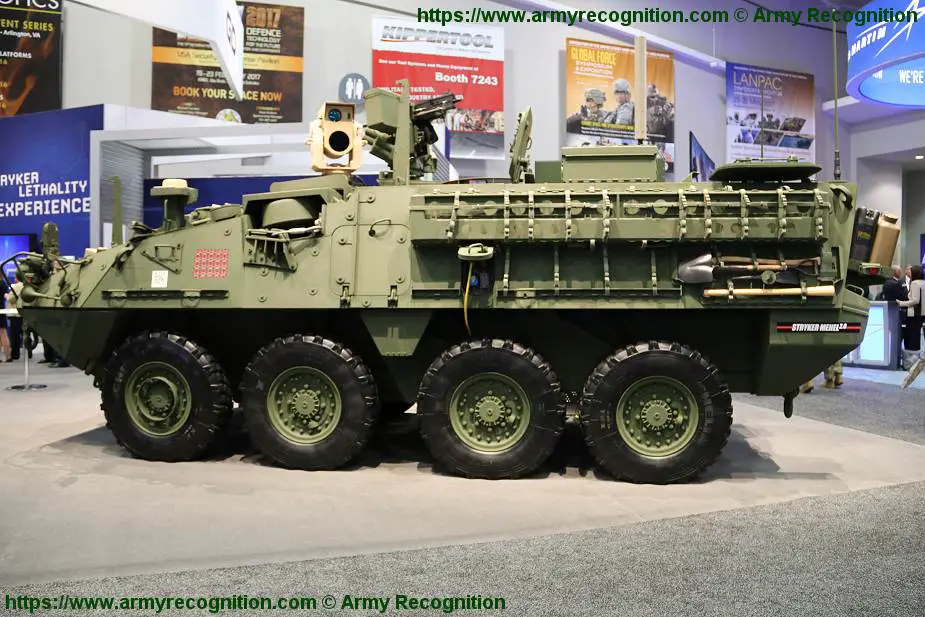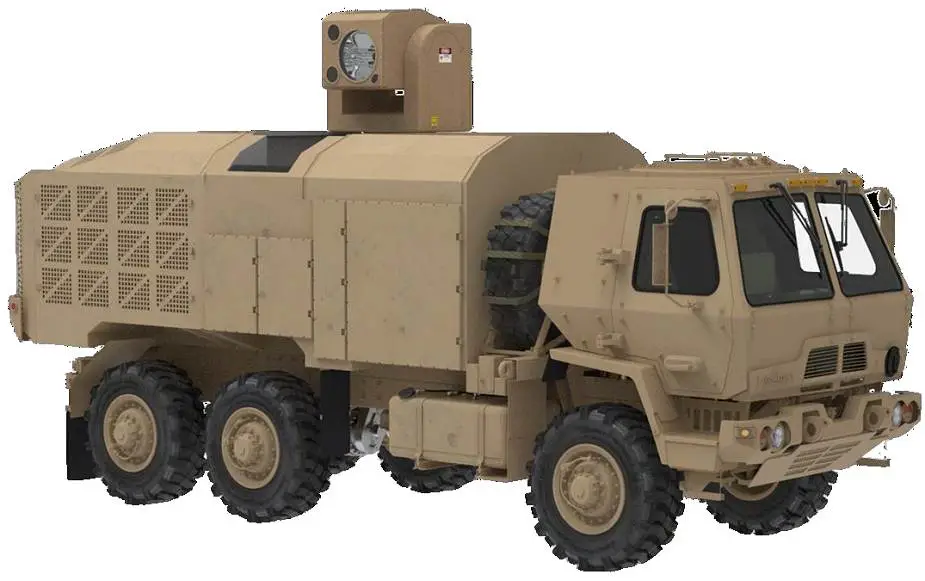Breaking news
US Army is ready to field two types of laser weapon systems in 2022.
According to information published by the USSAA News website on August 4, 2020, U.S. Army is ready to field two types of laser weapon systems in 2022 including a 50-kilowatt laser weapon that will be used to destroy drone and artillery rockets and a 300-kilowatt laser weapon which will be able to shoot down cruise missiles.
Follow Army Recognition on Google News at this link

Stryker 8x8 armored vehicle fitted with High Energy Laser weapon. (Picture source Army Recognition)
The future 50-kilowatt laser weapon will be fitted on Stryker armored vehicle and is named DE-MSHORAD (Directed Energy – Maneuver Short-Range Air Defense) in the U.S. Army. There are two companies that compete for the manufacturing of this new laser weapon including Northrop Grumman and Raytheon.
Both laser weapon systems will be build to be mounted on Stryker armored vehicles manufactured by the company General Dynamics. The DE-MSHORAD prototyping initiative is managed by the U.S. Army Rapid Capabilities and Critical Technologies Office (RCCTO), Redstone Arsenal, Alabama.
The U.S. Army's future M-SHORAD protection for forward-deployed soldiers includes laser weapon systems as an effective complement to kinetic capabilities in countering aerial threats, rockets, artillery, and mortars, and unmanned aircraft systems.
In August 2019, the US Army’s Rapid Capabilities and Critical Technologies Office (RCCTO) has selected Kord Technologies as the prime contractor to lead the U.S. Army Maneuver Short Range Air Defense (M-SHORAD) Directed Energy (DE) initiative. This new contract allows Kord to integrate 50-kilowatt (kW)-class laser weapon systems on Stryker combat vehicles to address the Army’s urgent need to defeat small Unmanned Aerial Systems (sUAS) and Rocket, Artillery, and Mortar (RAM) threats.
Currently, the U.S. Army also develops a new 300kW-class laser weapon prototype under the Indirect Fire Protection Capability-High Energy Laser (IFPC-HEL) program. In March 2020, the US Army has announced a plan to deliver 300 kW-class IFPC-HEL prototypes integrated on tactical vehicles to a platoon by Fiscal Year (FY) 2024, while initially demonstrating the 300 kW-class capability in FY22.
On November 25, 2019, an OSD (Office of the Secretary of Defense ) HELSI (High Energy Laser Scaling Initiative) contract was awarded to Lockheed Martin and Aculight Corporation supporting the demonstration of a stand-alone 300kW-class HEL system. The company is one of three high energy laser producers participating in the OSD-led initiative to develop and lab test a 300 kW-class laser in FY22. The Army is the OSD designated proponent for Lockheed Martin in this initiative, while the other companies are Nutronics, Inc., sponsored by the Navy, and General Atomics, sponsored by the Air Force.
In May 2020, the Company Dynetics has announced its work to increase the power of the laser weapon for the US Army program IFPC-HEL from a 100 kW-class system to a 300kW-class system. In late 2019, the U.S. Army Rapid Capabilities and Critical Technologies Office (RCCTO) also announced a High Energy Laser Scaling Initiative (HELSI) contract award by the Office of the Secretary of Defense (OSD) that will support the IFPC-HEL effort.
As the prime contractor for IFPC-HEL, Dynetics is set to demonstrate a 300 kW-class prototype system in FY22. The company will lead to final assembly, integration, and testing. The solution will provide continued support to defend against hostile unmanned aerial systems and rockets, artillery, and mortars. The IFPC-HEL prototype will inform the U.S. Army’s effort to field prototype units with residual combat capability by 2024.
According to pictures released on the Internet, the new 300 kW-class laser weapon will be integrated on an FMTV light truck manufactured by the company Oshkosh Defense.

Drawing of US Army Advances 300kW-class Laser Prototype integrated on FMTV truck. (Picture source U.S. Army)




























